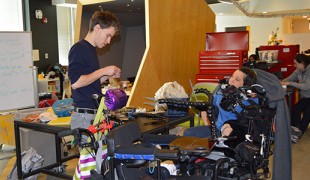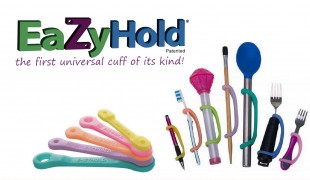- 10022
- 680
- 19
- 30
- 0
- Help Ukraine
About the solution
The robot, made of BPA plastics, works by having an arm which feeds the person. But first, the caregiver has to teach the robot the delivery location, and then it will take charge.
The arm selects virtually any properly sized food from one of four compartments. Then it delivers the food to one of several thousand potential locations where the diner can eat from the spoon.
Obi has a rechargeable battery which can work for about four hours, and can be carried around easily. On average, the device can serve from four to six meals without having to be recharged.
“We believe dining is one of life’s greatest pleasures that absolutely everyone should enjoy. What our device stands for is equally as important as what it does. It represents our belief that living with physical challenges can be fulfilling and inspiring. Technology, and specifically robotics, combined with modern design, should facilitate that”, the inventor explained.
In 2010 Jon and his father Tom founded their company - DESῙN – and they have been improving Obi so that it can be of assistance to more people globally.
“This has been an incredible journey to go from my dorm room prototype to having Obi units manufactured and ready to sell. During this journey, I’ve met so many amazing people who face incredible challenges with grace and strength. It’s an honor and privilege to be able to help them reclaim something as fundamental as eating a meal together with friends and family”, Jon stated.
Obi can be bought online, costing $4,500.
Adapted from: http://prn.to/29R3jGF
https://youtu.be/x_lrNuZlin4
More info: https://meetobi.com
这些解决方案不应包括使用药物,化学品或生物制品(包括食品);创伤性设备;冒犯性的,商业或内在危险的内容。该解决方案未经医学验证。请谨慎进行!如果您有任何疑问,请咨询健康专家。
DISCLAIMER: This story was written by someone who is not the author of the solution, therefore please be advised that, although it was written with the utmost respect for the innovation and the innovator, there can be some incorrect statements. If you find any errors please contact the patient Innovation team via info@patient-innovation.com
-
-
343
-
0
-
4972

Woman with disability invents assistive technology
CAREGIVING
Grip
Cerebral Palsy
Assistive Technology access
Assistive Daily Life Device (to help ADL)
Tremors
Muscle cramps or spasms
Difficulty coordinating movements
Stiffness or rigidity (difficulty moving)
Paralysis of the legs and lower body
Muscle weakness
Trouble with fine motor skills (e.g., writing, buttoning clothes)
Twitching or involuntary movements (myoclonus)
Restoring mobility
Promoting self-management
Managing Neurological Disorders
Promoting inclusivity and social integration
Caregiving Support
Medical Genetics
Neurology
Rheumatology
United States
-
-
-
554
-
0
-
9004

Man creates device to help to put on socks, shoes and even trousers
Grip
(SELF)-CARE: DRESSING: Dressing independently.
BODY BALANCE: Maintaining body balance
STANDING UP: Standing up from a seated position
Knee Deformity
Assistive Daily Life Device (to help ADL)
Strategy/Tip
Muscle weakness
Limited range of motion
Muscle pain or stiffness
Reduced grip force (grip)
Loss of muscle coordination
Muscle cramps or spasms
Joint deformity
Joint redness or warmth
Swelling or inflammation
Difficulty bearing weight
Muscle twitching
Difficulty standing from a seated position
Difficulty getting up from the floor
Numbness or tingling in the extremities
Joint pain or swelling
Restoring mobility
Promoting self-management
Preserving Organ Function
Rehabilitating After Stroke
Managing Neurological Disorders
Recovering from Traumatic Injuries
Maintaining Balance and Mobility
Preventing (Vaccination, Protection, Falls, Research/Mapping)
Caregiving Support
Internal Medicine
Neurology
Orthopedics
Physical Medicine and Rehabilitation
Rheumatology
Sports Medicine
Vascular Surgery
United States
-
-
-
354
-
0
-
4654

Sisters create solution for people who have difficulties holding objects
Grip
(SELF)-CARE: EATING: Eating independently.
Arthritis
Assistive Daily Life Device (to help ADL)
Muscle weakness
Limited range of motion
Reduced grip force (grip)
Loss of muscle coordination
Muscle cramps or spasms
Joint deformity
Joint redness or warmth
Muscle twitching
Joint pain or swelling
Managing pain
Promoting self-management
Internal Medicine
Neurology
Orthopedics
Physical Medicine and Rehabilitation
Rheumatology
United States
-
 zh
zh